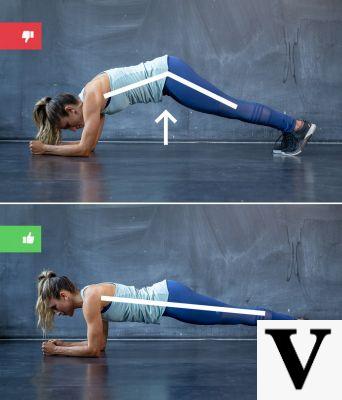
The push up plank is an exercise that consists of a transition from an elbow plank position to a push up position while keeping the feet firmly on the ground.
It is a closed kinetic chain exercise that involves the entire core as stabilizing muscles and those of the shoulders, arms, shoulder blade stabilizers and partly also the pectorals as motor muscles.
This type of exercise is well suited as a burnout at the end of the workout for the upper body or for a session of "push" or has its place even within a HIIT session.
execution
The execution of the push up plank is as follows:
- Start in a plank position with your forearms on the ground. The legs can remain slightly open or together. The latter variant requires a higher level of stability as the support base is reduced and the width of the feet is less than the width of the pelvis.
This predisposes the trunk more to oscillations which, in order to be avoided, force the anti-rotator muscles to work intensely. - Keep glutes, abs and quads contracted throughout the exercise. The shoulder blades should also remain extended throughout the exercise but this aspect already requires a medium level of strength. If you cannot keep your shoulder blades protracted when transitioning, at least try to keep them protracted in the plank and push-up positions.
- From the plank position, shift the weight to one side of the body and extend the unloaded arm by resting only the hand on this side. At this point, shift your weight to the other side and then extend the second arm as well. At this point you should be in a push up position on your hands. the opening of the arms should be approximately equal to the width of the
shoulders in order to exploit a maximum ROM. - From the push-up position, return to the plank position by performing the initial transition backwards: shift the weight to one side to place the opposite forearm on the ground and then shift the weight to the latter side to also support the second forearm.
- This sequence represents a repetition. The number of repetitions should be even as the work done on the first side is not the same as the work done on the second. Performing several sets always starting with the same side does not lead to the development of abnormal muscle imbalances but it is a good idea to equalize the work of both sides of the body.
- Breathing should be as follows: I inhale in the plank and push-up positions and exhale during the transitions. This allows for greater stability in the two phases of movement.
Muscles involved
The muscles involved are most of the muscles of the trunk and arms. The protagonists are the stabilizers or the rectus abdominis, the obliques and the transversus; these must work as dynamic stabilizers during the entire movement.
The work of shoulders and arms is not negligible as we find ourselves supporting a good weight on one limb while extending the other.
Shoulder stabilizers, especially the large serratus, have to work hard to keep the shoulder as a fixed point while the rest of the body moves.
If one tries to maintain shoulder protraction throughout the sequence, one should realize the important work that the large dentate has to do.
The shoulder should remain constantly in a position of strength or extra rotated; this allows for a lower risk of compression in the joint as well as greater stability.
This trick also forces the extra rotators to work as dynamic stabilizers. Do the buttocks have to work to keep the pelvis extended and back? to.
Common mistakes
Common mistakes can be the following:
- Losing core balance during transition phases. This occurs due to a weakness of the abdominal muscles or an inability to coordinate their action with movement. To solve this aspect it is necessary to reinforce the stability with simpler variants such as the front plank and the side plank or to focus more on the execution and then stop the exercise when the quality of the repetitions is lost. Then increase the number of reps according to your abilities.
- Using a tempo that is too fast. We tend to make this mistake in order to overcome as quickly as possible the transition phases which represent the moments of greatest instability and therefore the most demanding. Work on a small number of repetitions until correct execution begins to fail.
- Bend the elbows in the transition phase. This occurs due to weakness on the part of the shoulder blade and deltoid stabilizers. The extended arm position creates more leverage and therefore increases the work demand of these muscles. Work on elevated front planks resting on your hands.


























